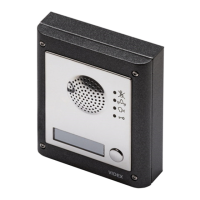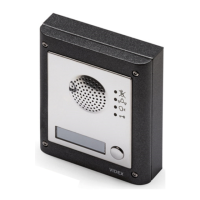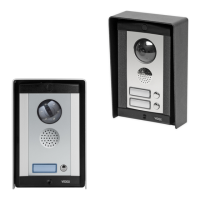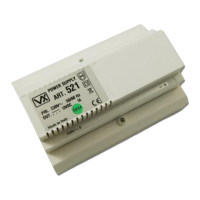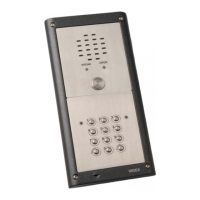66250754-4G-EN - V2.0 - 28/03/22
- 33 -
4000 Series GSM Audio Intercom - Technical Manual
4000 Series GSM Audio Intercom with Proximity
Fitting the SIM & Connecting Power
FITTING THE SIM CARD AND CONNECTING THE POWER TO THE GSM INTERCOM
After installing the power supply, antenna, lock output and any auxiliary devices as shown in this manual and before powering up, a
SIM card must be installed (the SIM must already be registered with the network provider). The SIM holder can be found on the back
of the module below the antenna connections. A nano SIM card from most network providers can be used, remember the 4G GSM
module will work with a 2G, 3G and a 4G SIM and will also work with the 3 network. Follow the steps below to insert the SIM card.
FITTING AND REMOVING THE SIM
Fitting the SIM:
1. Viewing the back of the GSM module place the nano SIM
on the SIM icon, with the SIM contacts facing down and
following the SIM orientation, as shown in Fig.48.
2. Carefully, using your index nger, guide the nano SIM left,
see Fig.49, into the SIM holder, see Fig.50.
3. Once the SIM is in place connect the GSM antenna and
then connect the 12Vdc power supply wires but DO NOT
power up the system yet.
4. Follow the initialisation process described below.
Removing the SIM:
1. Before removing the nano SIM disconnect the 12Vdc
power to the GSM module.
2. To remove the SIM card carefully use the end of a small
at head terminal driver (indicated with the two arrows
on the left side of the SIM holder where the edge of the
SIM can be seen, Fig.51) and gently push the nano SIM
to the right.
3. When the other side of the nano SIM sticks out of the SIM
holder on the right side carefully use your index nger to
slide the nano SIM out of the holder, Fig.52.
Fig. 48 Fig. 49
Fig. 50 Fig. 51
Fig. 52
POWER UP INITIALISATION SEQUENCE
The GSM module requires a short period of time to initialise properly. We recommend NOT
sending any SMS messages or pressing buttons during this time.
1. First check all the necessary connections have been made correctly, following the wiring
diagrams shown in this manual, and when ready power up the system.
2. The busy LED will start to ash continuously, as shown in Fig.53 (this will continue to ash
until the end of the initialisation process).
3. Two short beeps will be heard from the GSM followed by a short delay, as shown Fig.54.
4. Next a single short beep will be heard (in the meantime the busy LED will continue to ash
while it registers with the chosen network), then after a further short delay the busy LED
will stop ashing to indicate that the GSM has registered with the network, see Fig.55.
5. The GSM intercom is ready to be programmed.
IMPORTANT NOTE: On the back of GSM module the power & network status LED (refer
to Fig.7,
, page 14) will indicate one of the following either during the power up
initialisation cycle or when the GSM module is in standby:
• LED OFF - not connected to the network or the GSM module is powered down.
• LED ON - the GSM module is searching for a network or is in a call.
• LED ashing slowly (approx. 800ms ON/800ms OFF) GSM is registered to a 2G or 3G
network.
• LED ashing fast (approx. 200ms ON/200ms OFF) GSM is registered to a 4G network.
Fig. 53
...delay...
Fig. 54
...delay...
Fig. 55
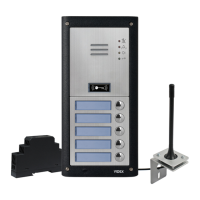
